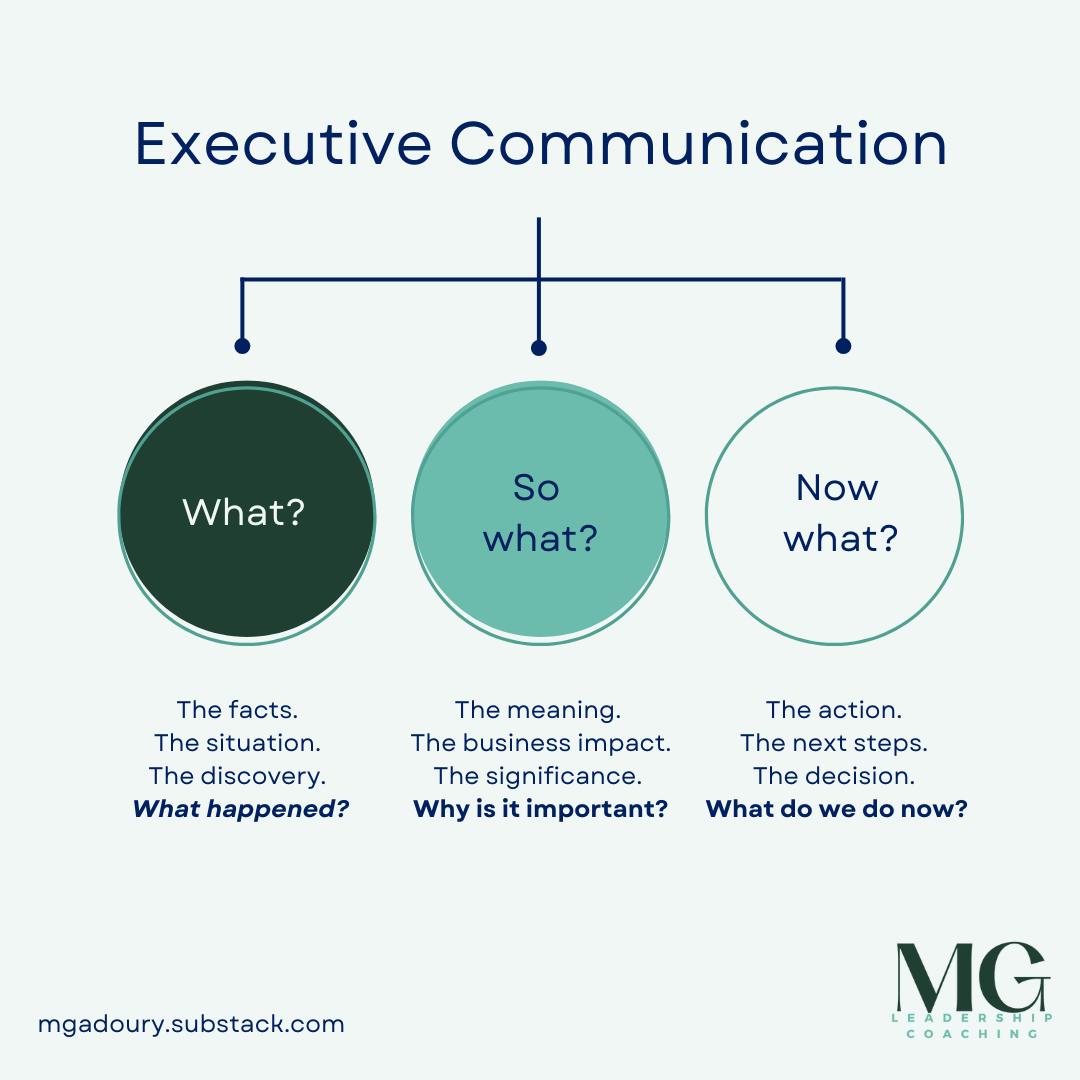Welcome to The Evolving Leader's Guide. Each week, I share one mindset, framework, or toolkit designed to help you become a more effective leader—so you can lead with confidence, inspire your team, and build a career you're proud of.
This Week's Tool: The What? So what? Now what? Framework
Last month, Sarah, my client, entered our session in a panic.
She was a sales director at a fast-growing tech company. Her team had plummeted from 100% of quota to 73% in just weeks. She knew exactly why: system bugs were delaying leads, web traffic was down, and her reporting dashboard had been broken for six weeks.
But every time she tried to explain this to leadership, she felt like she was long winded and people weren’t really listening.
She'd launch into detailed explanations about lead routing workflows, conversion optimization, and technical integration issues. The more context she provided, the more lost everyone looked.
"I keep trying to demonstrate that I understand everything that's happening," she told me. "But I'm starting to worry that all this detail makes me sound less confident, not more."
Sarah had fallen into the classic communication trap: trying to prove competence through complexity instead of clarity.
Her executives didn't need to understand her systems. They needed to understand her plan.
Sarah wasn't communicating like an executive.
The Secret Language of Leadership
Executives don't think like individual contributors. They can't afford to.
While you're deep in the weeds, they're juggling twelve priorities. They need information fast, clear, and actionable.
Most leaders miss this completely.
They present like they're still trying to prove they did their homework. When we aren't confident in our position, we feel compelled to justify ourselves with every detail we've uncovered. We dump data and hope someone else connects the dots.
But executives already assume you're smart. That's why you're in the room.
What they need is your judgment.
The Three-Part Formula
There's a simple framework that cuts through all the noise.
When you use it, you sound strategic instead of tactical. You look like leadership material instead of someone who needs managing. You come across as someone who gets the big picture instead of someone lost in the weeds.
They ask follow-up questions instead of cutting you off. They remember your updates instead of forgetting them five minutes later.
This framework matches exactly how they process information under pressure.
That's it. Three questions that transform rambling updates into executive-ready communication.
Three Examples That Show the Power
Here's the framework in action. Watch how the same information transforms when structured properly:
See the difference? Same information. Completely different impact.
Why It Works So Well
Most people think executives are impatient because they're rude. They're not.
They're impatient because they're drowning in decisions. Every conversation is competing with ten others for their mental bandwidth.
The What? So what? Now what? framework cuts through that noise because it delivers information the way their brains actually want to receive it.
Most people get stuck in "What?" mode. They describe everything they learned, every methodology they used, every challenge they faced.
Executives don't need your journey. They need your destination.
The "So what?" forces you to think like a business owner. Not just "here's what I found" but "here's why this matters to our goals."
The "Now what?" makes you sound decisive. Instead of presenting problems, you're presenting solutions.
The crucial thing to understand is that you're not doing less work. You're presenting it differently.
You still do all the research, analysis, and preparation. But you lead with the conclusion and let executives ask for the details that matter to them. When you bottom-line the information they need to know, they'll ask follow-up questions about the details that are most important to them.
Think of it like a presentation: Most people create 10 slides and present all 10. Executives want 2 slides presented and 8 slides in the appendix. You're not providing less information—you're letting them choose which information is relevant instead of forcing them to sift through everything to find what they care about.
Start using this framework immediately. In every email. Every presentation. Every casual update.
Your colleagues will notice the difference. Sarah certainly did. Two weeks after our call, she messaged me: "I have been using the framework more and it's getting easier." You'll sound more strategic. More decisive. More like leadership material.
You'll be communicating like an executive.
Most people spend years developing "executive presence." Executive presence isn't about how you dress or how confident you sound.
It's about how you communicate.
Communicating like an executive means leading with the conclusion that matters most.
Coach's Challenge
This week, rewrite three communications using What? So what? Now what?:
Pick your last team update email. Restructure it using the framework.
Take your next presentation and lead with “So what?” instead of background.
In your next meeting, practice giving updates in this format: fact, impact, action.
Watch how differently people respond when you talk like an executive instead of like someone trying to impress them with all of the things you know.
The framework works because it matches how leaders actually think. Use it, and you'll start sounding like one of them.






